From Malcolm X and Albert Einstein to the Civil War and the Great Depression, these colorized old photographs bring history to life like never before.
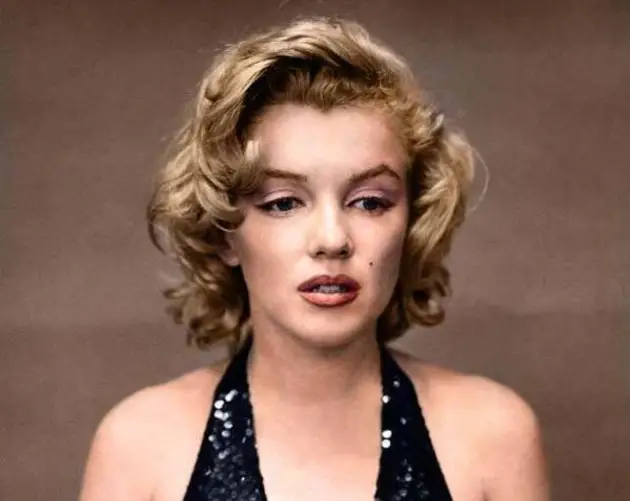
99 Stunning Colorized Photos That Breathe New Life Into The Past
Since the very first photographers started taking pictures in the 1820s, there have been people who colorized photos. The technology used to make colorized black-and-white photos has changed radically over the nearly two centuries since, but our desire to see an image of the world as it truly looks remains the same.
From the earliest hand-tinted photographs to the modern era of digitally colorized old photos, the work that goes into the colorization process has always been considerable. In fact, modern colorists don't necessarily have an easier time of it than those who were working 100 years ago. See the fruits of their labor in the gallery of colorized black-and-white photos above and discover more about their process below.
Bringing History To Life With Colorized Black-And-White Photos In The Modern Era
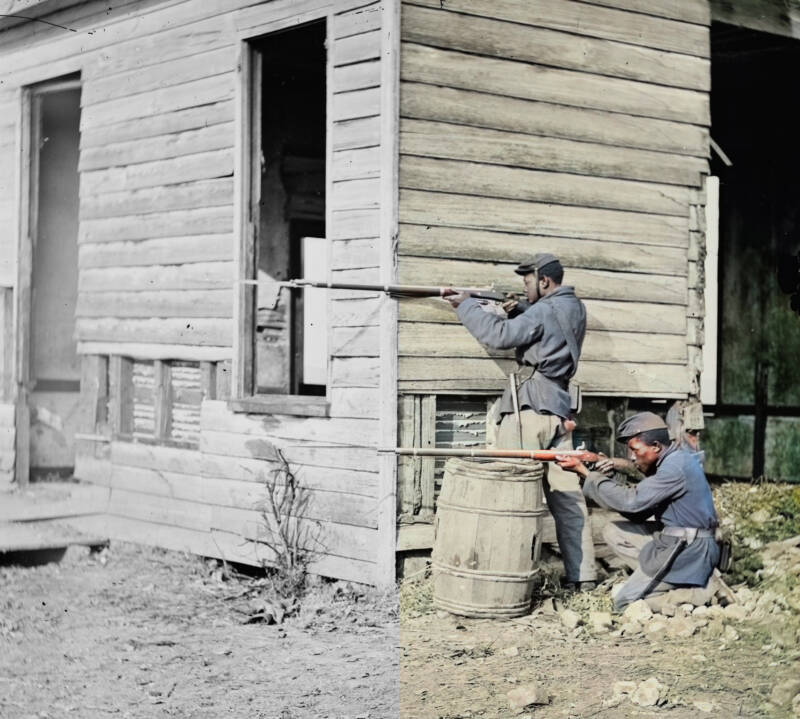
Library of Congress/Color by Matt LougheryA partially-colorized photo of African-American Union soldiers at Dutch Gap, Virginia during the Civil War in November 1864.
As scores of old black-and-white or sepia-toned photos have found new audiences online in recent years, there has been increased interest in taking these images and breathing new life into them through colorization. A new generation of colorists is carrying out this work and utilizing modern processes that weren't available in decades past.
Jordan Lloyd, for one, ranks among the more well-known people who've used these modern processes to colorize photos (see his work and that of the colorists mentioned below in the gallery above) — though he suggested that today's techniques don't always measure up to the old ways:
"Whether or not it's a photomechanical process or literally painting on top of the original, it could very well be considered an art back in those days, by highly skilled artisans. These days, I'm not so sure. I certainly don't consider myself an artist or even a colorist. I now use the term visual historian, because it's a more reflective term to describe my day-to-day job."
However, as colorist Matt Loughrey said, the emergence of digital technology means that colorized photos have entered a totally different era: "The single difference [between newer techniques and older ones] is that we are in a digital age and with that comes a great efficiency that could never exist in terms of hand-tinting or coloring."
Furthermore, these new techniques have changed the field of photo colorization by opening it up to newcomers like never before. In the words of Joel Bellviure of Cassowary Colorizations, "Nowadays, specialized software has 'democratized' photo editing, which means more and more people can contribute techniques and bring together a common historical landmark."
The Original Artistry Of Making Colorized Photos
Former Master Colorist for Whites Aviation, Grace Rawson, discusses the process of hand-tinting photos in the 1950s.
Long before modern techniques democratized the field, colorized photos were initially made by painters who painstakingly hand-tinted each image. Individual prints were often directly colored by an artist, making each a distinct item.
The cost, in terms of time and money, was high enough that colorization was largely reserved for commerce. If the colorized image could be sold or used in an advertisement geared toward selling something else, it'd be more likely to get colorized in the first place. But colorizations outside of commerce were few and far between.
"The high cost and specialization of the job meant hand-colored pictures were used for commercial purposes and rarely used to be spread as historical illustrations," said Bellviure. "Pictures were rather re-painted and idealized in order to publish them in history books and magazines... Many postcards were watercolored individually and then reproduced in large quantities."
However, some colorizations continued to be made individually. Grace Rawson, a Master Colorist who was employed by Whites Aviation aerial photography firm in New Zealand in the 1950s, said that "every single Whites Aviation photograph is an individual, hand-colored original. They were not prints, and that made them very special."

Grace Rawson/LoadingDocs/VimeoA hand-painted colorization by colorist Grace Rawson.
But as color photography became more ubiquitous after World War II, demand for colorized black-and-white photos for commercial purposes quickly waned and the lower cost of color film made the expense of a hand colorist impractical. Ultimately, however, the field of colorization found a new path and new techniques to match.
The Changing Purpose Of Colorized Black-And-White Photos
The work of the modern colorist isn't any less painstaking than the delicate work of earlier artists like Grace Rawson, even with all the computer software in the world. For one, many digital colorists still use a "brush" much like those who came before.
As Loughrey said, "For my own process, I needed an intuitive workflow, particularly in terms of hardware, and the solution to this was to move from mouse and desktop to the digital pen and tablet system." It's decades later and some colorists have returned to a method that, digital underpinnings aside, looks much like what artists were doing long ago.

National Archives/Color by Dana KellerWomen delivering ice in 1918.
And in a world awash in color photography, what kinds of images do colorists use these new methods like the pen and tablet to work on? The answer, of course, is historical black-and-white photographs from before the advent of color film. This rerouting of colorists' efforts away from commerce and advertising and toward historical recreation and archival research has drastically changed the nature of their work.
Earlier colorists may have been asked to colorize images featuring subjects that they themselves were familiar with. Rawson herself was able to go to the sites in New Zealand that were photographed by Whites Aviation photographers and study the colors personally. Others may have been present in a portrait studio when a photo was taken so they knew what colors to add to a black-and-white print.
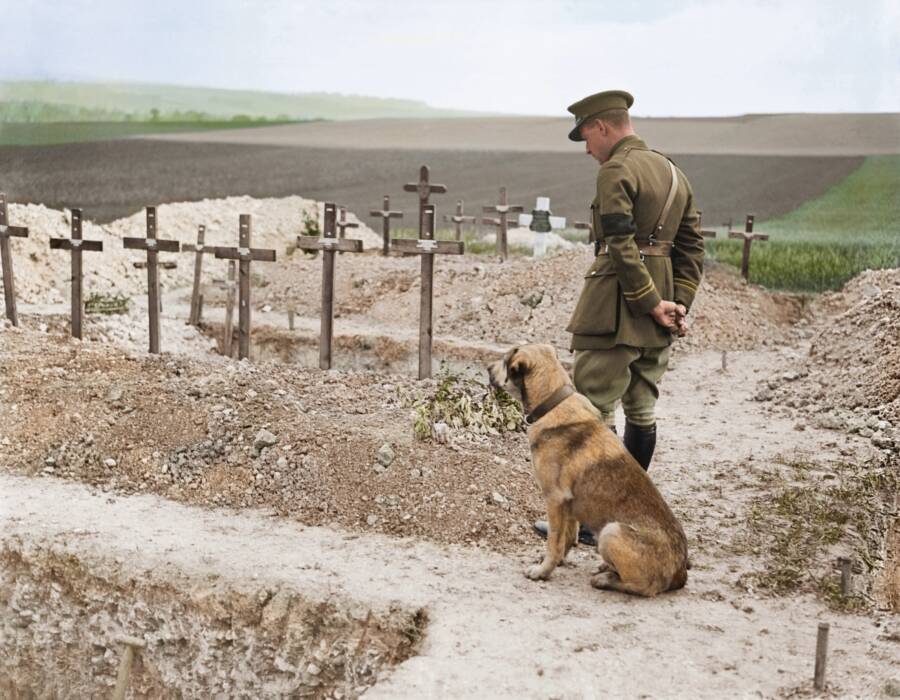
Flickr/Color by Cassowary ColorizationsA British officer and his dog at the Wavans War Cemetery in Pas de Calais, France in 1918.
But, today, how do you color a photo from a hundred years ago when the subjects in the photo may be dead, demolished, or otherwise gone forever?
Computer technology can help in some regards, Loughrey said. "I use proprietary software that understands the relationship between monochromatic shades and their corresponding hues of red, green and blue. The results of running the software present a logical palette to work with that's specific to textiles and tonality of flesh."
It's also important to try to somehow "see" the thing one is trying to colorize. "If I can't find the exact thing," Lloyd said, "then I should try and find a thing in the same group: a brand, a region, a manufacturer and so on. Failing that, something in the same era or type."
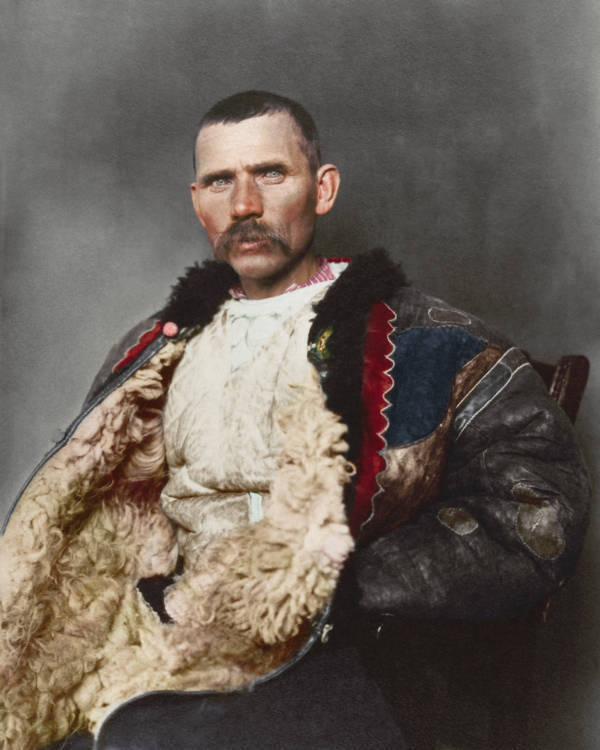
New York Public Library/Color by Jordan LloydA Romanian immigrant at Ellis Island, New York, circa early 1900s.
"It is in equal parts archive hunting, digital repairing, and restoration," said Lloyd, "sometimes digital reconstruction and a whole lot of historical research, on top of the bit where one spends hours masking and filling in the color."
"Color is certainly the result," said Lloyd, "but it does little to convey the often time-consuming and occasionally frustrating process it takes to arrive at that point."
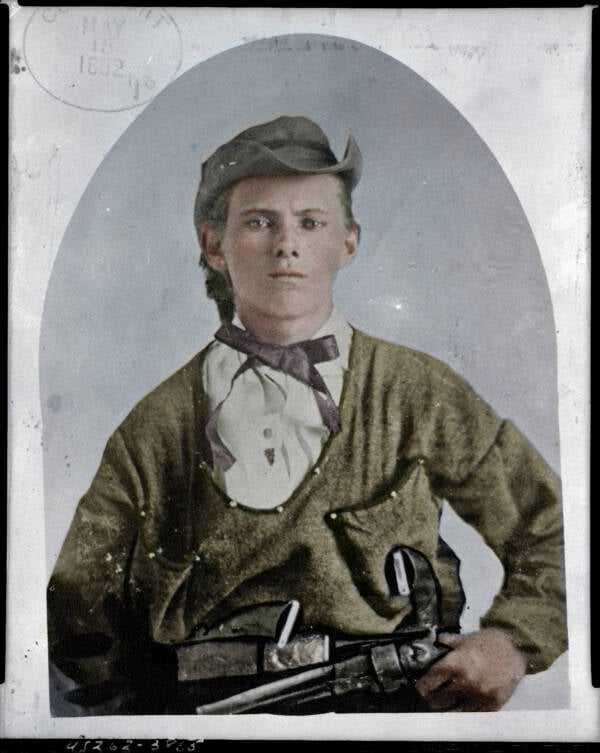
A portrait of a young Jesse James.
Indeed, digging into the history of these photographs is obviously necessary, and can be a mixed bag for the colorist. On the one hand, exploring the unique history behind the subject of a photograph can be an exhilarating experience. As Lloyd said, "It's my job to tease something out and turn it into a story people will find interesting."
On the other hand, however, sometimes the most important works are the most emotionally difficult.
"The hardest colorizations I attempted were those I published in a series of colorized photographs on the Holocaust," said Bellviure. "Meant to raise awareness of Holocaust denial, the pictures' graphic and heartbreaking honesty made it extremely hard to work on them."
Should We Create Colorized Photos At All?

J. Malcolm Greany/Wikimedia Commons/Color by Ben ThomasNature photographer Ansel Adams.
There have been some critics of colorized black-and-white photos who've argued that they distort history by reinterpreting a historical document and presenting it in such a way that confuses a colorized photo for a color one, an important distinction.
In a 2014 piece in Gizmodo, writer Matt Novak asked several important questions: "[W]hat happens if [the] colorized version becomes more popular than the black-and-white version? Should we care? Does it matter at all to history?"
As Novak also noted, some photographers might have had the option to use color photography but made conscious decisions not to do so. Wouldn't that make colorizing their work inappropriate? If the photographer chose black and white for artistic reasons, wouldn't colorizing the image be a form of vandalism?
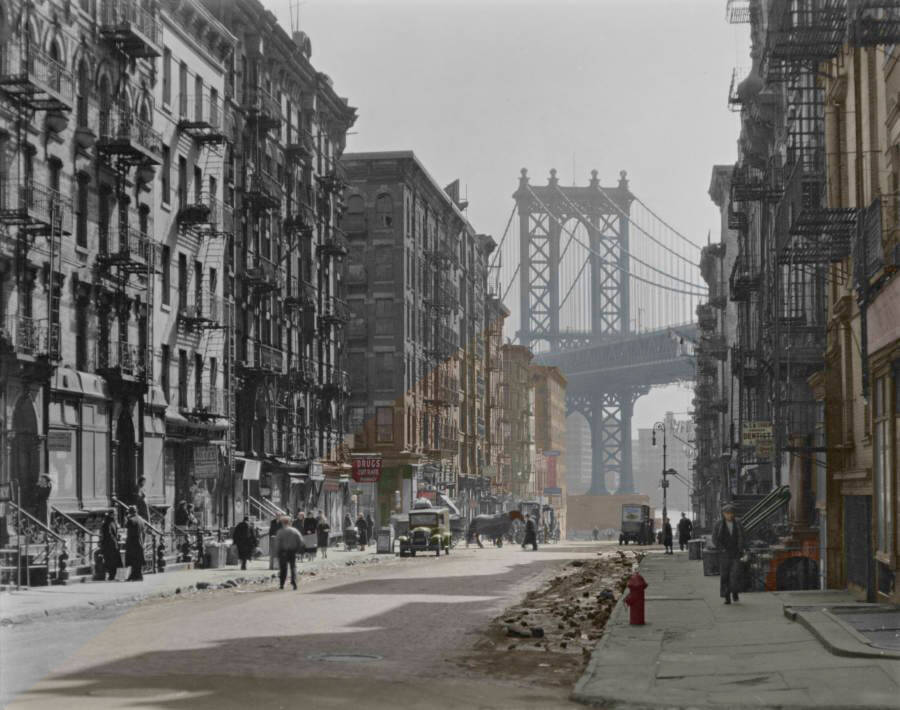
New York Public Library/Flickr/Color by Ryan StennesA partially colorized photo of Manhattan's Lower East Side in 1936.
However, in a 2014 interview with Novak, colorist Dana Keller said that this latest generation of artists "approach colorizing with a real reverence towards history, using their skills to eliminate the distraction of the "colorization," ultimately bringing these scenes to life with a natural realism that hopefully connects the viewer to the past in a new way."
"Equally as important," Keller added, "there is a great effort in preserving historical authenticity as well, with a lot of painstaking research in order to provide as accurate a depiction as possible."
Sometimes, perhaps, the way to most accurately bring the past to life is to overwrite the historical record that never got it all that correct in the first place. As Lloyd said, "Recorded history is also a history of the technology that makes the record in the first place."
After this look at the best colorized photos from throughout history, enjoy the most compelling colorized old photos from the Wild West. Then, see some stunning colorized black and white photos from the Civil War.